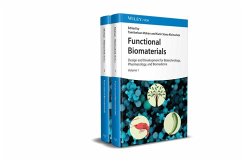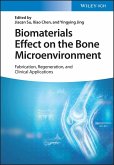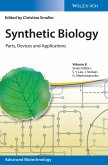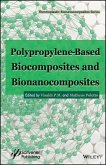Functional Biomaterials. 2 volumes
Design and Development for Biotechnology, Pharmacology, and Biomedicine
Herausgegeben:Mohan, Tamilselvan; Kleinschek, Karin Stana
Functional Biomaterials. 2 volumes
Design and Development for Biotechnology, Pharmacology, and Biomedicine
Herausgegeben:Mohan, Tamilselvan; Kleinschek, Karin Stana
- Gebundenes Buch
- Merkliste
- Auf die Merkliste
- Bewerten Bewerten
- Teilen
- Produkt teilen
- Produkterinnerung
- Produkterinnerung
This book merges the two most important trends in biomaterials: functionalization and renewable chemistry. It covers a variety of biopolymers and various approaches for the transformation of these biopolymers into functional units.
Andere Kunden interessierten sich auch für
![Biomaterials Effect on the Bone Microenvironment Biomaterials Effect on the Bone Microenvironment]() Biomaterials Effect on the Bone Microenvironment90,99 €
Biomaterials Effect on the Bone Microenvironment90,99 €![Biomedical Engineering Biomedical Engineering]() Hossein HosseinkhaniBiomedical Engineering149,00 €
Hossein HosseinkhaniBiomedical Engineering149,00 €![Synthetic Biology Synthetic Biology]() SmolkeSynthetic Biology169,99 €
SmolkeSynthetic Biology169,99 €![Electrospinning Electrospinning]() Electrospinning111,99 €
Electrospinning111,99 €![Polypropylene-Based Biocomposites and Bionanocomposites Polypropylene-Based Biocomposites and Bionanocomposites]() Polypropylene-Based Biocomposites and Bionanocomposites202,99 €
Polypropylene-Based Biocomposites and Bionanocomposites202,99 €![Advanced Theranostic Materials Advanced Theranostic Materials]() Ashutosh TiwariAdvanced Theranostic Materials200,99 €
Ashutosh TiwariAdvanced Theranostic Materials200,99 €![Piezoelectric Materials Piezoelectric Materials]() Piezoelectric Materials140,99 €
Piezoelectric Materials140,99 €-
-
-
This book merges the two most important trends in biomaterials: functionalization and renewable chemistry. It covers a variety of biopolymers and various approaches for the transformation of these biopolymers into functional units.
Hinweis: Dieser Artikel kann nur an eine deutsche Lieferadresse ausgeliefert werden.
Hinweis: Dieser Artikel kann nur an eine deutsche Lieferadresse ausgeliefert werden.
Produktdetails
- Produktdetails
- Verlag: Wiley-VCH
- Artikelnr. des Verlages: 1134771 000
- 1. Auflage
- Seitenzahl: 453
- Erscheinungstermin: 1. März 2023
- Englisch
- Abmessung: 250mm x 176mm x 39mm
- Gewicht: 1496g
- ISBN-13: 9783527347711
- ISBN-10: 3527347712
- Artikelnr.: 63693912
- Herstellerkennzeichnung
- Wiley-VCH GmbH
- Boschstraße 12
- 69469 Weinheim
- wiley.buha@zeitfracht.de
- Verlag: Wiley-VCH
- Artikelnr. des Verlages: 1134771 000
- 1. Auflage
- Seitenzahl: 453
- Erscheinungstermin: 1. März 2023
- Englisch
- Abmessung: 250mm x 176mm x 39mm
- Gewicht: 1496g
- ISBN-13: 9783527347711
- ISBN-10: 3527347712
- Artikelnr.: 63693912
- Herstellerkennzeichnung
- Wiley-VCH GmbH
- Boschstraße 12
- 69469 Weinheim
- wiley.buha@zeitfracht.de
Assist. Prof. Tamilselvan Mohan obtained his Master of Science in Chemistry in 2006 from the Kanchi Mamunivar Centre for Post Graduate Studies (KMCPGS), Pondicherry, India. In 2007, Dr. Mohan graduated from the Pondicherry University with a Master of Philosophy (M.Phil) degree in Chemistry. From 2007-2009, Dr. Mohan worked as a Junior Research Fellow (JRF) in the Pondicherry University (India) under the supervision of Prof. K. Anbalagan. Dr. Mohan pursued his Ph.D degree in the field of surface modification of polysaccharide cellulosic materials for Biosensor application from the University of Maribor, Maribor, Slovenia under the guidance of Prof. Karin Stana-Kleinschek. Dr. Mohan joined as a post-doctoral fellow (February-May 2013) in the group of Prof. Günter Reiter, Albert-Ludwig-University of Freiburg, Germany. From May 2013 - June 2017 he worked on the solid-liquid interface studies, design of nanoparticles-polymer composites and tailoring of natural (e.g. cellulose) and synthetic polymeric surfaces for obtaining new functional properties in the University of Graz in the group of Prof. Volker Ribitsch. Since July 2017 he is working in the group of Prof. Stana Kleinschek, University of Maribor, where he mainly focuses on the development of various types of functional materials for flame-retardant, paper conservation and tissue engineering applications. Prof. Karin Stana Kleinschek, obtained her PhD degree from the Institute of Physical Chemistry of the University of Graz, Austria. Her field of expertise is surface modification and characterization of polysaccharides and its usability in biomedical applications. She works as Full Professor at the Faculty of Mechanical Engineering of the University of Maribor (UM), where she teaches various courses on Polymer Chemistry, Surface Characterization of Polymeric Materials and Textile chemistry. From 2011- 2015 she was a Vice Rector for Research and Development of the UM. She is a member of various scientific organizations. Since 2013 she is a member of the European Academy for Science and Art and from 2014 associate member of Slovenian Academy of Engineering. Since October 2016 she is visiting professor at TU Graz. Her scientific bibliography consists of more than 1052 units, including 194 scientific peer-reviewed papers; she participates and coordinates numerous of national as well as international research projects.
PART I DEFINITIONS, SOURCES, STRUCTURE AND PROPERTIES OF BIOPOLYMERS AND BIOMATERIALS
Chapter 1: Definitions, types of biopolymers and biomaterials
Chapter 2: Biopolymers and their derivatives introduction, chemical, functional and structural classification
Chapter 3: Biopolymer isolation and preparation
Chapter 4: Biopolymer supramolecular structure and functions
PART II CHARACTERIZATION OF BIOMATERIALS
Chapter 5: Methods for characterization of morphological properties of biomaterials
Chapter 6: Methods for characterization of structural properties of biomaterials
Chapter 7: Methods for analysing the chemical composition of biomaterials
Chapter 8: Methods for characterization of dielectric and thermal properties of biomaterials
Chapter 9: Methods for characterization of surface properties and solid-liquid interaction studies of biomaterials
Chapter 10: Methods for analysing the biological and biomedical properties of biomaterials
PART III BIOPOLYMER ULTRATHIN (TWO-DIMENSIONAL) FILMS
Chapter 10: Biopolymer ultrathin films: recent trends and challenges
Chapter 11: Biopolymer-based flat thin films preparation, characterization and application
Chapter 12: Structuring and characterization of biopolymer-based thin films
Chapter 13: Application of biopolymer thin films in biomedical applications
a. In drug-delivery
b. Cell growth
c. Biological macromolecule (e.g. proteins, DNA, antibody) interactions
PART IV BIOPOLYMER-BASED NANOMATERIALS: CHALLENGES IN PREPARATION, CHARACTERIZATION AND APPLICATIONS
Chapter 14: Current synthesis methods, characterization and application of cellulose nanocrystals
Chapter 15: Preparation, characterization and biomedical application of Nano fibrillated cellulose
Chapter 16: Polysaccharide-based nanofibers synthesis, characterization and application in tissue engineering and regenerative medicine
Chapter 17: Polysaccharide nanoparticles different methods of synthesis and their interaction with cells and tissues
PART V POLYSACCHARIDE-BASED SCAFFOLDS: DESIGN, FABRICATION AND APPLICATION
Chapter 18: Methods and challenges in the preparation of scaffolds for tissue engineering application
Chapter 19: Solvent-casting approach for design of scaffold and their potential application
Chapter 20: Freeze-dried aerogel/foams for tissue engineering application
Chapter 21: Design and characterization of electro spun scaffolds for biomedical application
Chapter 22: Polysaccharide-beads preparation, characterization and application in tissue engineering
Chapter 23: recent advances in 3d printing in the design and application of cellulose-based polysaccharide scaffolds
a. In skin tissue engineering
b. In vascular tissue engineering
c. In bone tissue engineering
d. In cartilage tissue engineering
Chapter 1: Definitions, types of biopolymers and biomaterials
Chapter 2: Biopolymers and their derivatives introduction, chemical, functional and structural classification
Chapter 3: Biopolymer isolation and preparation
Chapter 4: Biopolymer supramolecular structure and functions
PART II CHARACTERIZATION OF BIOMATERIALS
Chapter 5: Methods for characterization of morphological properties of biomaterials
Chapter 6: Methods for characterization of structural properties of biomaterials
Chapter 7: Methods for analysing the chemical composition of biomaterials
Chapter 8: Methods for characterization of dielectric and thermal properties of biomaterials
Chapter 9: Methods for characterization of surface properties and solid-liquid interaction studies of biomaterials
Chapter 10: Methods for analysing the biological and biomedical properties of biomaterials
PART III BIOPOLYMER ULTRATHIN (TWO-DIMENSIONAL) FILMS
Chapter 10: Biopolymer ultrathin films: recent trends and challenges
Chapter 11: Biopolymer-based flat thin films preparation, characterization and application
Chapter 12: Structuring and characterization of biopolymer-based thin films
Chapter 13: Application of biopolymer thin films in biomedical applications
a. In drug-delivery
b. Cell growth
c. Biological macromolecule (e.g. proteins, DNA, antibody) interactions
PART IV BIOPOLYMER-BASED NANOMATERIALS: CHALLENGES IN PREPARATION, CHARACTERIZATION AND APPLICATIONS
Chapter 14: Current synthesis methods, characterization and application of cellulose nanocrystals
Chapter 15: Preparation, characterization and biomedical application of Nano fibrillated cellulose
Chapter 16: Polysaccharide-based nanofibers synthesis, characterization and application in tissue engineering and regenerative medicine
Chapter 17: Polysaccharide nanoparticles different methods of synthesis and their interaction with cells and tissues
PART V POLYSACCHARIDE-BASED SCAFFOLDS: DESIGN, FABRICATION AND APPLICATION
Chapter 18: Methods and challenges in the preparation of scaffolds for tissue engineering application
Chapter 19: Solvent-casting approach for design of scaffold and their potential application
Chapter 20: Freeze-dried aerogel/foams for tissue engineering application
Chapter 21: Design and characterization of electro spun scaffolds for biomedical application
Chapter 22: Polysaccharide-beads preparation, characterization and application in tissue engineering
Chapter 23: recent advances in 3d printing in the design and application of cellulose-based polysaccharide scaffolds
a. In skin tissue engineering
b. In vascular tissue engineering
c. In bone tissue engineering
d. In cartilage tissue engineering
PART I DEFINITIONS, SOURCES, STRUCTURE AND PROPERTIES OF BIOPOLYMERS AND BIOMATERIALS
Chapter 1: Definitions, types of biopolymers and biomaterials
Chapter 2: Biopolymers and their derivatives introduction, chemical, functional and structural classification
Chapter 3: Biopolymer isolation and preparation
Chapter 4: Biopolymer supramolecular structure and functions
PART II CHARACTERIZATION OF BIOMATERIALS
Chapter 5: Methods for characterization of morphological properties of biomaterials
Chapter 6: Methods for characterization of structural properties of biomaterials
Chapter 7: Methods for analysing the chemical composition of biomaterials
Chapter 8: Methods for characterization of dielectric and thermal properties of biomaterials
Chapter 9: Methods for characterization of surface properties and solid-liquid interaction studies of biomaterials
Chapter 10: Methods for analysing the biological and biomedical properties of biomaterials
PART III BIOPOLYMER ULTRATHIN (TWO-DIMENSIONAL) FILMS
Chapter 10: Biopolymer ultrathin films: recent trends and challenges
Chapter 11: Biopolymer-based flat thin films preparation, characterization and application
Chapter 12: Structuring and characterization of biopolymer-based thin films
Chapter 13: Application of biopolymer thin films in biomedical applications
a. In drug-delivery
b. Cell growth
c. Biological macromolecule (e.g. proteins, DNA, antibody) interactions
PART IV BIOPOLYMER-BASED NANOMATERIALS: CHALLENGES IN PREPARATION, CHARACTERIZATION AND APPLICATIONS
Chapter 14: Current synthesis methods, characterization and application of cellulose nanocrystals
Chapter 15: Preparation, characterization and biomedical application of Nano fibrillated cellulose
Chapter 16: Polysaccharide-based nanofibers synthesis, characterization and application in tissue engineering and regenerative medicine
Chapter 17: Polysaccharide nanoparticles different methods of synthesis and their interaction with cells and tissues
PART V POLYSACCHARIDE-BASED SCAFFOLDS: DESIGN, FABRICATION AND APPLICATION
Chapter 18: Methods and challenges in the preparation of scaffolds for tissue engineering application
Chapter 19: Solvent-casting approach for design of scaffold and their potential application
Chapter 20: Freeze-dried aerogel/foams for tissue engineering application
Chapter 21: Design and characterization of electro spun scaffolds for biomedical application
Chapter 22: Polysaccharide-beads preparation, characterization and application in tissue engineering
Chapter 23: recent advances in 3d printing in the design and application of cellulose-based polysaccharide scaffolds
a. In skin tissue engineering
b. In vascular tissue engineering
c. In bone tissue engineering
d. In cartilage tissue engineering
Chapter 1: Definitions, types of biopolymers and biomaterials
Chapter 2: Biopolymers and their derivatives introduction, chemical, functional and structural classification
Chapter 3: Biopolymer isolation and preparation
Chapter 4: Biopolymer supramolecular structure and functions
PART II CHARACTERIZATION OF BIOMATERIALS
Chapter 5: Methods for characterization of morphological properties of biomaterials
Chapter 6: Methods for characterization of structural properties of biomaterials
Chapter 7: Methods for analysing the chemical composition of biomaterials
Chapter 8: Methods for characterization of dielectric and thermal properties of biomaterials
Chapter 9: Methods for characterization of surface properties and solid-liquid interaction studies of biomaterials
Chapter 10: Methods for analysing the biological and biomedical properties of biomaterials
PART III BIOPOLYMER ULTRATHIN (TWO-DIMENSIONAL) FILMS
Chapter 10: Biopolymer ultrathin films: recent trends and challenges
Chapter 11: Biopolymer-based flat thin films preparation, characterization and application
Chapter 12: Structuring and characterization of biopolymer-based thin films
Chapter 13: Application of biopolymer thin films in biomedical applications
a. In drug-delivery
b. Cell growth
c. Biological macromolecule (e.g. proteins, DNA, antibody) interactions
PART IV BIOPOLYMER-BASED NANOMATERIALS: CHALLENGES IN PREPARATION, CHARACTERIZATION AND APPLICATIONS
Chapter 14: Current synthesis methods, characterization and application of cellulose nanocrystals
Chapter 15: Preparation, characterization and biomedical application of Nano fibrillated cellulose
Chapter 16: Polysaccharide-based nanofibers synthesis, characterization and application in tissue engineering and regenerative medicine
Chapter 17: Polysaccharide nanoparticles different methods of synthesis and their interaction with cells and tissues
PART V POLYSACCHARIDE-BASED SCAFFOLDS: DESIGN, FABRICATION AND APPLICATION
Chapter 18: Methods and challenges in the preparation of scaffolds for tissue engineering application
Chapter 19: Solvent-casting approach for design of scaffold and their potential application
Chapter 20: Freeze-dried aerogel/foams for tissue engineering application
Chapter 21: Design and characterization of electro spun scaffolds for biomedical application
Chapter 22: Polysaccharide-beads preparation, characterization and application in tissue engineering
Chapter 23: recent advances in 3d printing in the design and application of cellulose-based polysaccharide scaffolds
a. In skin tissue engineering
b. In vascular tissue engineering
c. In bone tissue engineering
d. In cartilage tissue engineering








